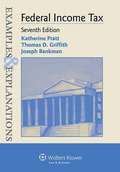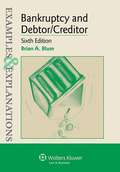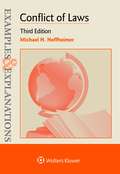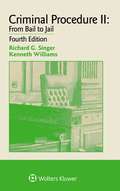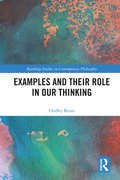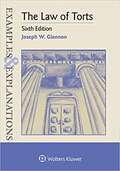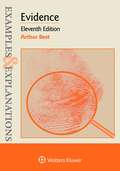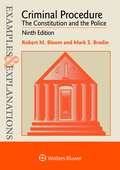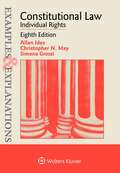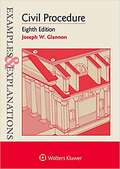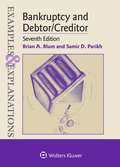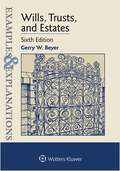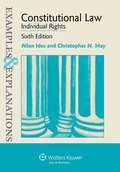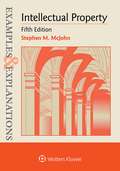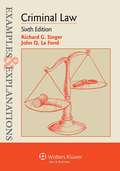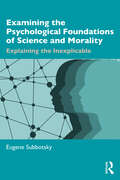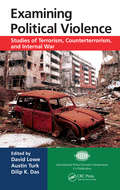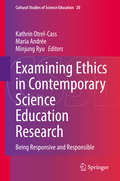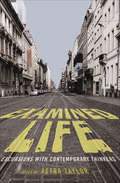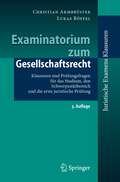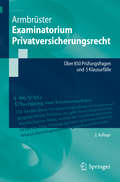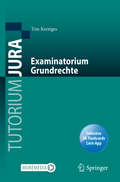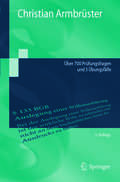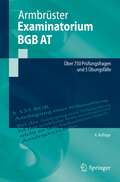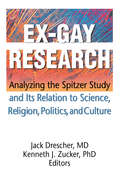- Table View
- List View
Examples & Explanations Federal Income Tax,Seventh Edition
by Katherine Pratt Thomas D. Griffith Joseph BankmanA favorite among successful students, and often recommended by professors, the unique Examples & Explanations series gives you extremely clear introductions to concepts followed by realistic examples that mirror those presented in the classroom throughout the semester. Use at the beginning and midway through the semester to deepen your understanding through clear explanations, corresponding hypothetical fact patterns, and analysis. Then use to study for finals by reviewing the hypotheticals as well as the structure and reasoning behind the accompanying analysis. Designed to complement your casebook, the trusted Examples & Explanations titles get right to the point in a conversational, often humorous style that helps you learn the material each step of the way and prepare for the exam at the end of the course.
Examples & Explanations: Bankruptcy & Debtor/Creditor Sixth Edition
by Brian A. BlumThis book offers basic overview of debt collection under state law and an introduction to concepts and principles that underlie both state debtor/creditor law and bankruptcy.
Examples & Explanations: Conflict of Laws Third Edition
by Michael H. HoffheimerThis book includes the basic material covered in a standard Conflict of Laws courses. It begins with an overview (Chapter 1) that describes the topics and introduces the jargon. It covers domicile, personal jurisdiction, and forum selection (Part I); choice of law approaches (Parts II-VI); constitutional limits on choice of law (Part VII); rules for enforcing judgments (Part VIII); and proof of foreign law (Part IX).
Examples Explanations: Criminal Procedure Ii From Bail To Jail 4e (Examples And Explanations Ser.)
by SingerA favorite classroom prep tool of successful students that is often recommended by professors, the Examples & Explanations (E&E) series provides an alternative perspective to help you understand your casebook and in-class lectures. Each E&E offers hypothetical questions complemented by detailed explanations that allow you to test your knowledge of the topics in your courses and compare your own analysis. Here’s why you need an E&E to help you study throughout the semester: Clear explanations of each class topic, in a conversational, funny style. Features hypotheticals similar to those presented in class, with corresponding analysis so you can use them during the semester to test your understanding, and again at exam time to help you review. It offers coverage that works with ALL the major casebooks, and suits any class on a given topic. The Examples & Explanations series has been ranked the most popular study aid among law students because it is equally as helpful from the first day of class through the final exam.
Examples and Their Role in Our Thinking (Routledge Studies in Contemporary Philosophy)
by Ondřej BeranThis book investigates the role and significance that examples play in shaping arguments and thought, both in philosophy and in everyday life. It addresses questions about how our moral thinking is informed by our conceptual practices, especially in ways related to the relationship between ethics and literature, post-Wittgensteinian ethics, or meta-philosophical concerns about the style of philosophical writing. Written in an accessible and non-technical style, the book uses examples from real-life events or pieces of well-known fictional stories to introduce its discussions. In doing so, it demonstrates the complex way examples, rather than exemplifying philosophical points, inform and condition how we approach the points for which we want to argue. The author shows how examples guide or block our understanding in certain directions, how they do this by stressing morally relevant aspects or dimensions of the terms, and how the sense of moral seriousness allows us to learn from examples. The final chapter explores whether these kinds of engagement with examples can be understood as "thinking primarily through examples." Examples and Their Role in Our Thinking will be of interest to scholars and graduate students working in ethics and moral philosophy, philosophy of language, and philosophy of literature.
Examples And Explanations For The Law Of Torts (Examples And Explanations Ser.)
by Joseph W. GlannonA favorite among successful students, and often recommended by professors, the unique Examples & Explanations series gives you extremely clear introductions to concepts followed by realistic examples that mirror those presented in the classroom throughout the semester. Use at the beginning and midway through the semester to deepen your understanding through clear explanations, corresponding hypothetical fact patterns, and analysis. Then use to study for finals by reviewing the hypotheticals as well as the structure and reasoning behind the accompanying analysis. Designed to complement your casebook, the trusted Examples & Explanations titles get right to the point in a conversational, often humorous style that helps you learn the material each step of the way and prepare for the exam at the end of the course. The unique, time-tested Examples & Explanations series is invaluable to teach yourself the subject from the first day of class until your last review before the final. Each guide: helps you learn new material by working through chapters that explain each topic in simple language challenges your understanding with hypotheticals similar to those presented in class provides valuable opportunity to study for the final by reviewing the hypotheticals as well as the structure and reasoning behind the corresponding analysis quickly gets to the point in conversational style laced with humor remains a favorite among law school students is often recommended by professors who encourage the use of study guides works with ALL the major casebooks, suits any class on a given topic provides an alternative perspective to help you understand your casebook and in-class lectures
Examples And Explanations For Evidence (Examples And Explanations Ser.)
by Arthur BestA favorite among successful students, and often recommended by professors, the unique Examples & Explanations series gives you extremely clear introductions to concepts followed by realistic examples that mirror those presented in the classroom
Examples And Explanations For Criminal Procedure: The Constitution And The Police (Examples And Explanations)
by Robert M. Bloom Mark S. BrodinA favorite classroom prep tool of successful students that is often recommended by professors, the Examples & Explanations (E&E) series provides an alternative perspective to help you understand your casebook and in-class lectures. Each E&E offers hypothetical questions complemented by detailed explanations that allow you to test your knowledge of the topics in your courses and compare your own analysis. Here’s why you need an E&E to help you study throughout the semester: Clear explanations of each class topic, in a conversational, funny style. Features hypotheticals similar to those presented in class, with corresponding analysis so you can use them during the semester to test your understanding, and again at exam time to help you review. It offers coverage that works with ALL the major casebooks, and suits any class on a given topic. The Examples & Explanations series has been ranked the most popular study aid among law students because it is equally as helpful from the first day of class through the final exam.
Examples and Explanations for Constitutional Law: Individual Rights (Examples and Explanations Series)
by Alan Ides Christopher N. May Simona GrossiA favorite classroom prep tool of successful students that is often recommended by professors, the Examples & Explanations (E&E) series provides an alternative perspective to help you understand your casebook and in-class lectures. Each E&E offers hypothetical questions complemented by detailed explanations that allow you to test your knowledge of the topics in your courses and compare your own analysis. <p><p> Here's why you need an E&E to help you study throughout the semester: <p> Clear explanations of each class topic, in a conversational, funny style. <p> Features hypotheticals similar to those presented in class, with corresponding analysis so you can use them during the semester to test your understanding, and again at exam time to help you review. <p> It offers coverage that works with ALL the major casebooks, and suits any class on a given topic. <p><p> The Examples & Explanations series has been ranked the most popular study aid among law students because it is equally as helpful from the first day of class through the final exam.
Examples and Explanations for Civil Procedure
by Joseph W. GlannonA favorite classroom prep tool of successful students that is often recommended by professors, the Examples & Explanations (E&E) series provides an alternative perspective to help you understand your casebook and in-class lectures. Each E&E offers hypothetical questions complemented by detailed explanations that allow you to test your knowledge of the topics in your courses and compare your own analysis. <P><P> Here's why you need an E&E to help you study throughout the semester: Clear explanations of each class topic, in a conversational, funny style. Features hypotheticals similar to those presented in class, with corresponding analysis so you can use them during the semester to test your understanding, and again at exam time to help you review. It offers coverage that works with ALL the major casebooks, and suits any class on a given topic. The Examples & Explanations series has been ranked the most popular study aid among law students because it is equally as helpful from the first day of class through the final exam.
Examples and Explanations for Bankruptcy and Debtor/Creditor
by Brian A. Blum Samir D. ParikhA favorite among successful students, and often recommended by professors, the unique Examples & Explanations series gives you extremely clear introductions to concepts followed by realistic examples that mirror those presented in the classroom throughout the semester. Use at the beginning and midway through the semester to deepen your understanding through clear explanations, corresponding hypothetical fact patterns, and analysis. Then use to study for finals by reviewing the hypotheticals as well as the structure and reasoning behind the accompanying analysis. Designed to complement your casebook, the trusted Examples & Explanations titles get right to the point in a conversational, often humorous style that helps you learn the material each step of the way and prepare for the exam at the end of the course. <P><P> The unique, time-tested Examples & Explanations series is invaluable to teach yourself the subject from the first day of class until your last review before the final. Each guide: <P><P> helps you learn new material by working through chapters that explain each topic in simple languagechallenges your understanding with hypotheticals similar to those presented in class <P><P>provides valuable opportunity to study for the final by reviewing the hypotheticals as well as the structure and reasoning behind the corresponding analysis <P><P>quickly gets to the point in conversational style laced with humorremains a favorite among law school studentsis often recommended by professors who encourage the use of study guidesworks with ALL the major casebooks, suits any class on a given topic <P><P>provides an alternative perspective to help you understand your casebook and in-class lectures
Examples and Explanations: Wills, Trusts and Estates
by Gerry W. BeyerA favorite among successful students, and often recommended by professors, the unique Examples & Explanations series gives you extremely clear introductions to concepts followed by realistic examples that mirror those presented in the classroom throughout the semester. Use at the beginning and midway through the semester to deepen your understanding through clear explanations, corresponding hypothetical fact patterns, and analysis. Then use to study for finals by reviewing the hypotheticals as well as the structure and reasoning behind the accompanying analysis. Designed to complement your casebook, the trusted Examples & Explanations titles get right to the point in a conversational, often humorous style that helps you learn the material each step of the way and prepare for the exam at the end of the course.
Examples and Explanations: Constitutional Law, Individual Rights (6th Edition)
by Allan Ides Christopher N. MayConstitutional Law, Individual Rights, part of a two-volume set, is a problem-oriented guide to the principle doctrines of constitutional law as covered in the typical course. This straightforward text walks the student through the constitutional provisions that protect individual rights: Takings and Contracts clauses, Due Process, Freedoms of Speech and Religion, and Equal Protection.
Examples and Explanations: Intellectual Property 5e
by Stephen M. McjohnUsing proven Examples & Explanations pedagogy, this comprehensive study guide provides students with a short account of the law, followed by a variety of concrete examples and explanations that help reinforce and give substance to the key rules and concepts in intellectual property law. Its flexible organization lets students move freely between topics that range from copyrights, to patents, trademarks and trade secrets. Keyed to all major IP survey courses and using compelling examples, Intellectual Property: Examples & Explanations is a straightforward guide that gives students a solid grounding in this dynamic area of law.
Examples and Explanations: Criminal Law (Sixth Edition)
by Richard G. Singer John Q. La FondA favorite among successful students, and often recommended by professors, the unique Examples & Explanations series gives you extremely clear introductions to concepts followed by realistic examples that mirror those presented in the classroom throughout the semester. Use at the beginning and midway through the semester to deepen your understanding through clear explanations, corresponding hypothetical fact patterns, and analysis. Then use to study for finals by reviewing the hypotheticals as well as the structure and reasoning behind the accompanying analysis. Designed to complement your casebook, the trusted Examples & Explanations titles get right to the point in a conversational, often humorous style that helps you learn the material each step of the way and prepare for the exam at the end of the course. The unique, time-tested Examples & Explanations series is invaluable to teach yourself the subject from the first day of class until your last review before the final. Each guide:helps you learn new material by working through chapters that explain each topic in simple language challenges your understanding with hypotheticals similar to those presented in class provides valuable opportunity to study for the final by reviewing the hypotheticals as well as the structure and reasoning behind the corresponding analysis quickly gets to the point in conversational style laced with humor remains a favorite among law school students is often recommended by professors who encourage the use of study guides works with ALL the major casebooks, suits any class on a given topic provides an alternative perspective to help you understand your casebook and in-class lectures
Examining the Psychological Foundations of Science and Morality: Explaining the Inexplicable
by Eugene SubbotskyExamining the Psychological Foundations of Science and Morality is a progressive text that explores the relationship between psychology, science and morality, to address fundamental questions about the foundations of psychological research and its relevance for the development of these disciplines. Supported by original empirical evidence, the book analyses the relationship of folk psychology to rational knowledge, outlining an original theory that connects psychology and natural sciences through the mind which creates a psychological foundation for scientific knowledge and morality. It argues that science and religion have a common psychological core of subjective experience, which diversifies into knowledge, beliefs and morality. The book considers how subjective space and time are converted into physical space and time, and how subjective ‘sense of causation’ is shaped into physical causality and human communication. Further, it explores the mind as a complex system of contrasting realities, with the main function being existence attribution (EXON). The chapters delve into a range of topics including theoretical analysis of consciousness, the internal self, unexplainable phenomena, analysis of empirical research into causality, morality and the mind. The book will be of great interest to postgraduate and upper-level undergraduate students studying foundations of psychology, consciousness, philosophy of science, morality, as well as professionals who deal with influence on mass consciousness or are interested in the link between human psychology, scientific knowledge and morality.
Examining Political Violence: Studies of Terrorism, Counterterrorism, and Internal War (International Police Executive Symposium Co-Publications)
by David Lowe Austin Turk Dilip K. DasA collection of works, some previously published as articles in the journal Police Practice and Research, this book provides both conceptual analysis and case studies, exploring historical and sociopolitical contexts of conflicts in order to help readers better understand these themes. The book defines the concepts of terrorism and radicalization, discusses countering terrorism through intelligence gathering, and examines different policing models. The conclusions drawn from these findings may assist in combating terrorism and political violence around the world. This book is a co-publication with the International Police Executive Symposium (IPES).
Examining Ethics in Contemporary Science Education Research: Being Responsive and Responsible (Cultural Studies of Science Education #20)
by Kathrin Otrel-Cass Maria Andrée Minjung RyuThis book poses questions on how to work ethically in research on science education. Applying research ethics reflectively and responsibly is fundamental for conducting research with people. It seeks to renew the conversation on how and why to engage with ethics in science education research and to adjust and refine research practices. It highlights both the need for methodological reflections in science education research and the particular ethical research challenges of science education. Science education research involves the study of people – often young and vulnerable people – and their practices. Researchers working within humanities and social science research commonly follow guidelines and codes of conducts set by country-specific ethics committees. Such guidelines function as minimal requirement for ethical reflection. This book seeks to engage the community of science education researchers in a conversation on ethics in science education moving beyond the mere compliance with governmental regulations toward a collective reflection. It asks the question of whether the existing guidelines provided for researchers are keeping up with contemporary realities of the visual presence of individuals in digital spaces. It also asks questions on how participatory research methodologies alters the relations between researchers and practitioners. This book is organized into two parts: Part one is entitled Challenging existing norms and practices. It asks questions such as: What are the conditions of knowledge that shape ethical decision making? Where is this kind of knowledge coming from? How is this knowledge structured, and where are the limitations? How can we justify our beliefs concerning our ethical research actions? Part two Epistemological considerations for ethical science education research centres norms and practices of conducting science education research in regard to methods, validity and scope.
Examined Life: Excursions with Contemporary Thinkers
by Astra TaylorPhilosophy reconnects with daily life in these conversations with eight renowned thinkers—the uncut interviews from the documentary film Examined Life. Astra Taylor&’s documentary film Examined Life took philosophy out of the academy and into the streets, reminding us that great ideas are born through profound engagement with the hustle and bustle of everyday life, not in isolation from it. This companion volume features the complete and uncut interviews with eight influential philosophers, all conducted while on the move through public spaces that resonate with their ideas. Slavoj Žižek ponders the purpose of ecology inside a London garbage dump. Peter Singer&’s thoughts on the ethics of consumption are amplified against the backdrop of Fifth Avenue&’s posh boutiques. Michael Hardt ponders the nature of revolution while surrounded by symbols of wealth and leisure. Judith Butler and a friend stroll through San Francisco&’s Mission District, questioning our culture&’s fixation on individualism. And while driving through Manhattan, Cornel West—perhaps America&’s best-known public intellectual—compares philosophy to jazz and blues, reminding us how intense and invigorating the life of the mind can be. Offering exclusive moments with great thinkers in fields ranging from moral philosophy to cultural theory to gender studies, Examined Life reveals philosophy&’s power to transform the way we see the world around us and to imagine our place within it.
Examinatorium zum Gesellschaftsrecht: Klausuren und Prüfungsfragen für das Studium, den Schwerpunktbereich und die erste juristische Prüfung (Juristische ExamensKlausuren)
by Christian Armbrüster Lukas BöffelDas Examinatorium deckt das gesamte examensrelevante Spektrum zum Gesellschaftsrecht ab. Neben Personen- und Kapitalgesellschaftsrecht werden auch Grundzüge des Konzernrechts erfasst. Das Klausurentraining dient Studierenden und Examenskandidaten zur Wiederholung, Vertiefung und fallbezogenen Anwendung des Prüfungsstoffes. Die große Prüfungsrelevanz der Fälle und zahlreiche Hinweise zur Prüfungsvorbereitung erleichtern zudem die Umsetzung bereits erworbenen Basiswissens im Schwerpunkt und Examen. Die Neuauflage berücksichtigt bereits vollumfänglich die zahlreichen und prüfungsrelevanten Gesetzesänderungen im Personengesellschaftsrecht, die ab dem 1. Januar 2024 infolge des MoPeG gelten. Der Autor Armbrüster ist Inhaber eines Lehrstuhls für Gesellschaftsrecht an der Freien Universität Berlin und prüft seit Jahrzehnten regelmäßig im Schwerpunktbereich und mündlichen Examensprüfungen Gesellschaftsrecht ab. Der Autor Böffel hat an diesem Lehrstuhl als wiss. Mitarbeiter mehrere Jahre gearbeitet und während dieser Zeit schriftliche Schwerpunktleistungen im Gesellschaftsrecht als Gutachter bewertet. Beide Autoren sind daher mit den Anforderungen, die an Studierende und Examenskandidaten gestellt werden, bestens vertraut.
Examinatorium Privatversicherungsrecht: Über 850 Prüfungsfragen und 5 Klausurfälle (Springer-Lehrbuch)
by Christian ArmbrüsterDas Examinatorium umfasst über 850 Fragen und Antworten sowie fünf Klausurfälle mit Lösungshinweisen zum Privatversicherungsrecht. Der inhaltliche Schwerpunkt liegt auf dem Versicherungsvertragsrecht des VVG; einbezogen werden aber auch das Gleichbehandlungsrecht (AGG), das Versicherungsaufsichtsrecht, das Versicherungsunternehmensrecht sowie Fragen des internationalen Rechts (Kollisionsrecht, europäisches Versicherungsvertragsrecht). Das Werk ermöglicht insbesondere Studierenden, aber auch allen mit der Materie in der Praxis befassten Juristen, ihren Wissensstand zu überprüfen sowie zu erweitern.
Examinatorium Grundrechte (Tutorium Jura)
by Tim KerstgesEine effiziente Klausurvorbereitung macht es erforderlich, den Blick auf das Wesentliche zu fokussieren. Genau darauf ist dieses Buch ausgerichtet. Der gesamte prüfungsrelevante Stoff aus dem Bereich Staatsrecht II (Grundrechte) wird kompakt und übersichtlich im didaktisch besonders effektiven Frage-Antwort-Format vermittelt. Die Fallbearbeitung im Rahmen einer Klausur ist das mit Abstand wichtigste Prüfungsformat im Jurastudium. Trotzdem kommt gerade die Vermittlung der erforderlichen Klausurtechnik und des richtigen Schreibstils in der juristischen Ausbildung oft zu kurz. Die Übungsfälle im zweiten Teil dieses Examinatoriums sollen diese Lücke schließen. Auf einen ausführlichen Fußnotenapparat, ausufernde Erläuterungen und unnötige Streitdarstellungen wird verzichtet. Ziel ist es, jeweils eine Lösung aufzuzeigen, welche die wesentlichen Aspekte argumentativ behandelt und deren Anfertigung zeiteffizient und damit realistisch ist. Zusätzliche Fragen per App: Laden Sie die Springer Nature Flashcards-App kostenlos herunter und nutzen Sie exklusives Zusatzmaterial, um Ihr Wissen zu prüfen.
Examinatorium BGB AT: Über 700 Prüfungsfragen und 3 Übungsfälle (Springer-Lehrbuch)
by Christian ArmbrüsterDas Werk umfasst über 700 Fragen und Antworten sowie drei Übungsfälle auf Examensniveau zum BGB AT. Dabei werden insbesondere auch Querverbindungen zwischen den verschiedenen Themenfeldern aufgezeigt, in der Art, wie sie in mündlichen Prüfungen gern abgefragt werden. Neben zahlreichen zusätzlichen Fragen enthält die Neuauflage erstmals auch Vertiefungshinweise, die den Nutzern die Prüfungsvorbereitung zusätzlich erleichtern dürften. Das Buch bezweckt, sämtliche examensrelevanten Themen abzuhandeln.
Examinatorium BGB AT: Über 750 Prüfungsfragen und 5 Übungsfälle (Springer-Lehrbuch)
by Christian ArmbrüsterDas Werk umfasst über 750 Fragen und Antworten sowie fünf Übungsfälle auf Examensniveau zum BGB AT. Dabei werden insbesondere auch Querverbindungen zwischen den verschiedenen Themenfeldern aufgezeigt, in der Art, wie sie in mündlichen Prüfungen gern abgefragt werden. Neben zahlreichen zusätzlichen Fragen enthält die Neuauflage auch Vertiefungshinweise, die den Nutzern die Prüfungsvorbereitung zusätzlich erleichtern. Das Buch bezweckt, sämtliche examensrelevanten Themen abzuhandeln.
Ex-Gay Research: Analyzing the Spitzer Study and Its Relation to Science, Religion, Politics, and Culture
by Jack Drescher Kenneth J ZuckerDefenders and critics of the controversial Spitzer study analyze its methodologies and findingsIn 2001, Robert L. Spitzer, MD, presented his study on sexual conversion therapy with its controversial findings that some homosexuals can change their sexual orientation. The resulting media sensation and political firestorm enraged the study&’s critics and emboldened its supporters. Ex-Gay Research: Analyzing the Spitzer Study and Its Relation to Science, Religion, Politics, and Culture presents leading experts examining Spitzer&’s research methodology and findings to discern whether the study itself deserves deeper consideration or outright dismissal. Every facet of the study is reviewed to discuss the positive or negative aspects of the results, its significance in political and social terms, and the implications for the future. Dr. Spitzer himself was an instrumental figure in the American Psychiatric Association's decision in 1973 to remove homosexuality as a mental illness listing from the Diagnostic and Statistical Manual-III. His later study that states that in some individuals, homosexuality may be more fluid than previously thought stirred controversy in the psychiatric community and society at large. His study is presented here to allow the reader to evaluate and consider it for themselves. Leading experts then voice their own pro or con views on the methodology and findings. Ex-Gay Research: Analyzing the Spitzer Study and Its Relation to Science, Religion, Politics, and Culture fearlessly illustrates the sometimes fuzzy boundary between science and politics, courageously spotlighting the culture wars now dividing our society.Ex-Gay Research: Analyzing the Spitzer Study and Its Relation to Science, Religion, Politics, and Culture discusses: the ex-gay movement the nature of scientific inquiry the relationship between science and politics the results of sexual conversion therapies gay and lesbian rightsEx-Gay Research: Analyzing the Spitzer Study and Its Relation to Science, Religion, Politics, and Culture is essential reading for sex researchers, mental health professionals, pastoral counselors, political activists, and any person asking if one can truly "change" his or her homosexuality.
